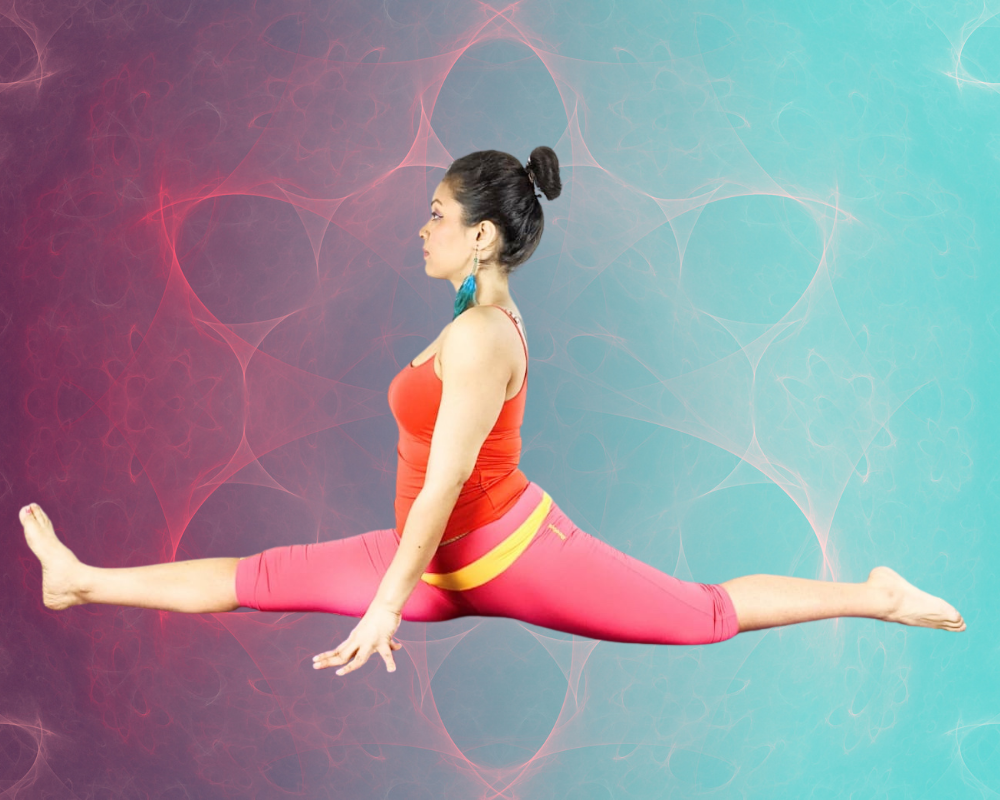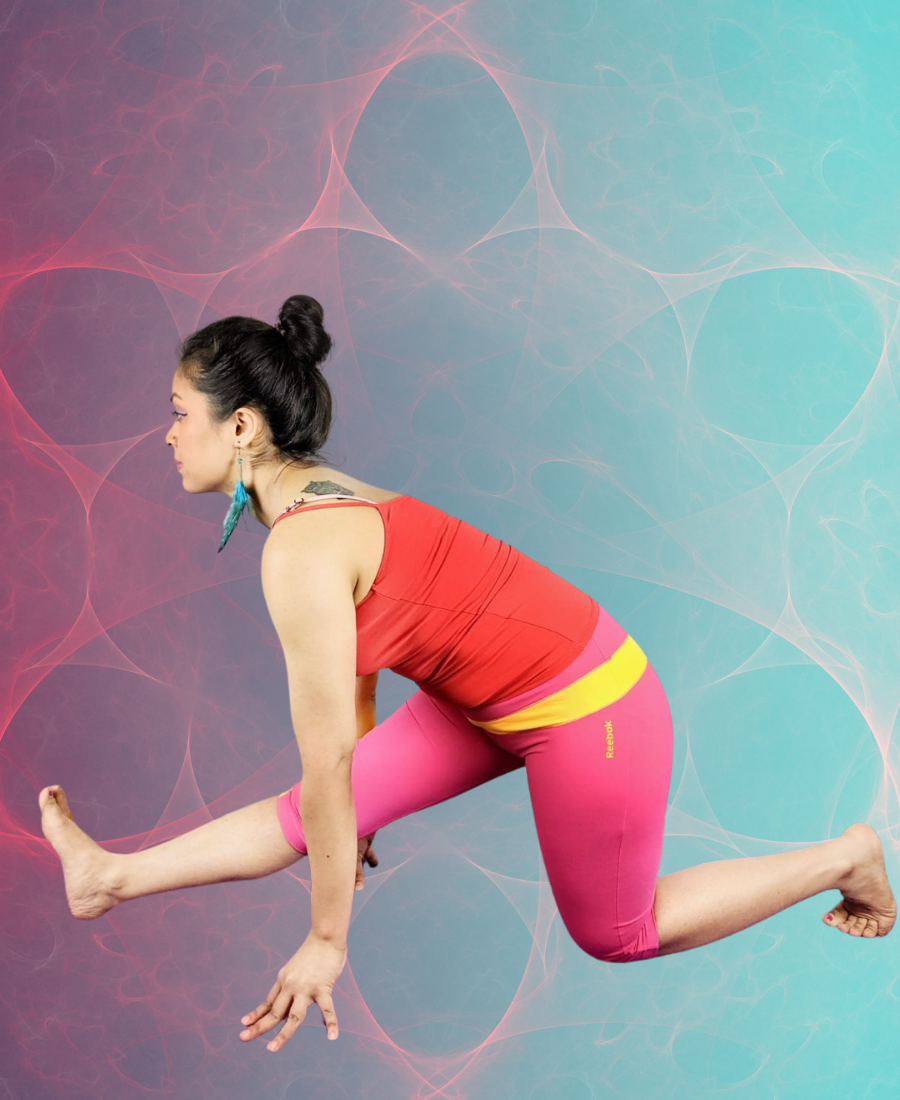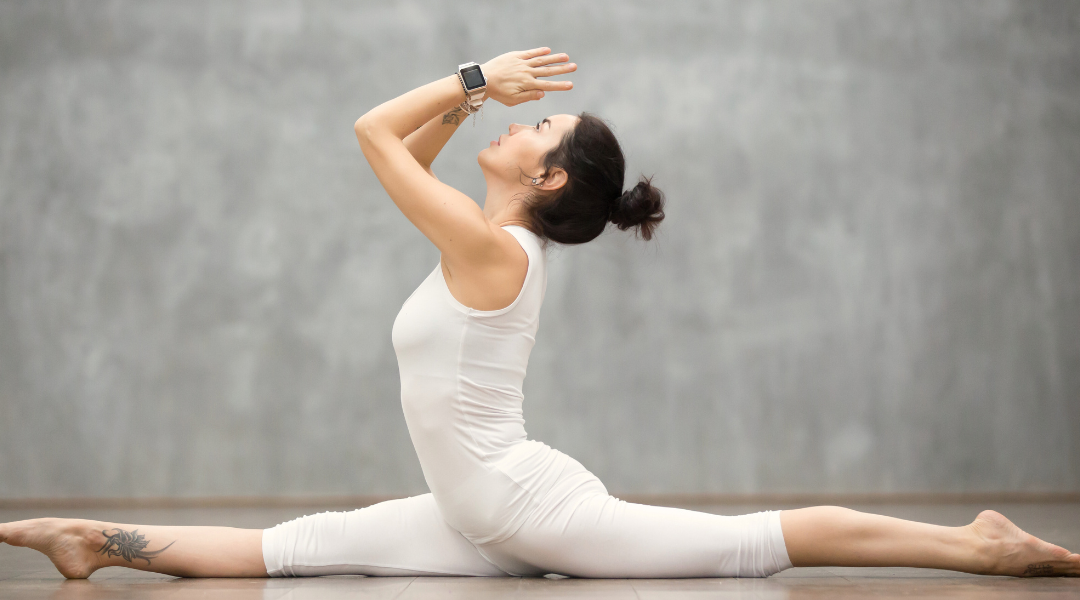Hanumanasna or monkey pose is a full-front split that makes you fearless and courageous. The pose is dedicated to the Hindu deity Hanuman. Hanumanasana teaches us self-love, patience, and respect towards the body. The pose has a deeper meaning and teaches us to have devotion. Hanumanasana or front splits requires body balance, flexibility, and is an advanced stretch.
Mythology and Meaning of Hanumanasana
Hanuman personifies bravery, physical strength, fearlessness, courage, and spiritual devotion. Yoga splits or Hanumanasana in its full expression represents the pose Hanuman took as he leaped from the southern tip of India to Sri Lanka to rescue Sita, Lord Rama’s wife from the clutches of the Demon king Ravana. Hanuman’s faith and devotion towards Lord Rama helped him bring Sita back to him. This same faith and devotion can be applied in Hanumanasana.
The other giant leap which Hanuman took was from the south of India to the Himalayas to get a herb to save Lakshaman’s life who was seriously injured in the battle. Hanuman’s giant leap shows his love and devotion for Rama. His implicit devotion and faith allowed him to do the impossible.
Hanumana leaped across huge distances fearlessly which would have taken huge courage. Similarly, we can also bring some courage into our lives by taking a leap of faith. Having trust in yourself can help you develop courage. This courage can help us overcome obstacles and do the impossible.
When we practice Hanumanasana with devotion we not only benefit ourselves but others around us also. When we leave the mat, we take with us an open heart, quiet and focussed mind, and more compassionate temperament.
The pose demands you to stretch your legs but at the same time bring pure devotion to the practice. The pose teaches us that nothing is impossible for a devoted soul.
When you do the pose and you feel pain, you turn your mind inward. So, instead of focussing on the pain, you use your breath to find that inner passion that made Hanuman take the giant leap. When you do this, the resistance dissolves and you start moving into the pose. Your hips, hip flexors, and hamstrings open up.
Benefits of Hanumanasana
- Great pose for opening the hamstrings and hip flexors.
- Increases flexibility, range of movement, and alignment.
- Strengthens the abdominal muscles and pelvic floor.
- Balances the nervous system.
- Tones the leg muscles.
- Stimulates the digestive organs.
- Develops self-love, creativity, and stability within the practitioner.
How to do Hanumanasana or Front Splits?

Instructions
- Kneel or start in a lunge pose with your right foot in front, placing your knee over your ankle.
- Put both your hands on the floor beside your right leg.
- Your back knee or the left knee is on the floor and the top of your foot on the mat.
- Now exhale press your palms to the floor and slowly start sliding the front foot forward by lifting the balls of your foot. Extend your right leg as far as your hamstrings allow you to. You may want to stop at half split pose or Ardha Hanumanasana. Keep breathing while you allow your front leg to slide forward.
- As you straighten your right leg forward keep pushing the left leg back so your back thigh gets closer to the floor. Make sure your left leg remains straight from the hip and does extend towards the side.
- Try to level the pelvis by pressing the inner thighs instead of reaching to the ground. Keep your hips square. The toes of your right foot should point to the sky.
- Try to stay in the pose for a few breaths and gradually work your way up to a few minutes.
- To release, gently shift your weight to the side of your right leg pressing your hands on the floor and sit on your right hip and bring your legs together.
Tips
- If you have stiff and tight hips and hamstrings, place two blocks on either side of your front thigh and put your hands on them. This is done to give you more support.
- For more support put a bolster or block underneath your front hip so that you don’t rely only on your hands.
- Placing a folded blanket under your back knee to prevent it from getting hurt.
- Avoid practicing yoga splits if you suffer from Hernia, slipped disc, dislocated hip joint, sciatica, or injuries in the pelvis, hips, knees, hamstrings, and ankles.
Preparatory poses
- Upavistha Konasana
- Prasarita Padottanasana
- Janusirsasana
- Paschimottanasana
- Uttanasana
- Baddha Konasana
Followup poses
- Natarajasana
- Paschimottanasana
- Eka pada rajakapotasana
Variations
Ardha Hanumanasana or Half Split

Instructions
- Kneel on the floor with the tops of your feet flat on the mat.
- Inhale and as you exhale extend your right leg out in front with the heel on the floor and foot flexing upwards.
- Pressing your fingertips into the ground, shift your torso slightly forward.
- Now try to take your left leg slightly back.
- Keep your head in line with your spine and hips square.
- Gently fold over the right leg by bending at the hips, taking your chest forward. Do not round your spine.
- Hold the pose for 5 to 10 seconds and take deep breaths.
- To come out of the pose, inhale, and as you exhale drag your right leg toward you. Repeat it on the other side.
Tips
- The knee of the front leg can be slightly bent.
- If you feel challenging to have your hands down on the mat, elevate your hands on blocks or walk them closer toward your body.
- If you feel discomfort in your back knee place a blanket or towel underneath for added support.
Hanumanasana with Blocks

Instructions
- Start with a low lunge and place a bolster or blanket under the top of your back thigh.
- You can also put your blocks under your hands for support.
- Now from here, lower your left sitting bone onto the mat.
- Do not try to make your back leg completely straight.
- Press your hands into the blocks and slightly elevate your left knee.
- Keep your hips square and resist a forward tilt in your pelvis which can lead to overarching of the lower back.
- Stay in the position for a few breaths and repeat it on the other side.
Tips
- Do not try to make your back leg completely straight.
- Draw your torso upright by pressing into the blocks.
Hanumanasana at the Wall

Instructions
- Stand close to the wall with back against the wall. Take your arms over your head, bend at your hips, and bring your hands on the floor. You have to decide how much stretch you want
- Do not lock your knees. Rest your body weight on your hands and the right foot that stays on the floor.
- Now raise your left leg. Place the ball of your foot against the wall and slowly slide your left leg up the wall. Use your arms to support majority of the weight. Keep breathing as you take your leg up.
- Keep your hips square and do not let them rotate outwards. You can curl your toes to keep the hips aligned.
- Once you find stability, walk your hands closer towards the wall to get a deeper stretch.
- Hold the position for a few breaths.
- To come out of the pose, slowly walk your hands out. Come down on your knees and repeat it on the other leg.
Tips
- Do not rotate the knee of the standing leg as this can damage the knee.
- If you feel any pain stop there and rest.
- You may be more flexible on one side. However, you may need to practice on both sides.
The Takeaway
Hanumanasana is not just a yoga pose but holds a lot of meaning that can help us connect to our deeper self and explore the big life questions. It is a challenging pose and its full expression can take some time. However, faith and dedication can help you find ease and steadiness in the pose.


